History of the Byzantine Empire
| History of the Byzantine Empire |
|---|
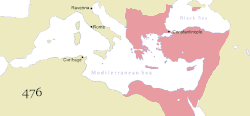 |
| Preceding |
|
| Early period (330–717) |
|
| Middle period (717–1204) |
| Late period (1204–1453) |
| Timeline |
| By topic |
|
|
This history of the Byzantine Empire covers the history of the
The borders of the Empire evolved significantly over its existence, as it went through several cycles of decline and recovery. During the reign of
During the
The final centuries of the Empire exhibited a general trend of decline. It struggled to recover during the 12th century, but was delivered a mortal blow during the Fourth Crusade, when Constantinople was sacked and the Empire dissolved and divided into competing Byzantine Greek and Latin realms. Despite the eventual recovery of Constantinople and re-establishment of the Empire in 1261, Byzantium remained only one of several small rival states in the area for the final two centuries of its existence. Its remaining territories were progressively annexed by the Ottomans over the 15th century. The Fall of Constantinople to the Ottoman Empire in 1453 finally ended the Roman Empire.
Tetrarchy
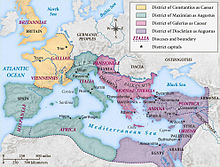
During the 3rd century, three crises threatened the Roman Empire: external invasions, internal civil wars and an economy riddled with weaknesses and problems.[6] The city of Rome gradually became less important as an administrative centre. The crisis of the 3rd century displayed the defects of the heterogeneous system of government that Augustus had established to administer his immense dominion. His successors had introduced some modifications, but events made it clearer that a new, more centralized and more uniform system was required.[7]
Constantine I and his successors
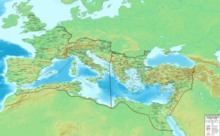
Constantine moved the seat of the Empire, and introduced important changes into its civil and religious constitution.[10] In 330, he founded Constantinople as a second Rome on the site of Byzantium, which was well-positioned astride the trade routes between East and West; it was a superb base from which to guard the Danube river, and was reasonably close to the Eastern frontiers. Constantine also began the building of the great fortified walls, which were expanded and rebuilt in subsequent ages. J. B. Bury asserts that "the foundation of Constantinople [...] inaugurated a permanent division between the Eastern and Western, the Greek and the Latin, halves of the Empire—a division to which events had already pointed—and affected decisively the whole subsequent history of Europe."[7]
Constantine built upon the administrative reforms introduced by Diocletian.
Constantine the Great inaugurated the Constantine's Bridge (Danube) at Sucidava, (today Celei in Romania)[15] in 328, in order to reconquer Dacia, a province that had been abandoned under Aurelian. He won a victory in the war and extended his control over the South Dacia, as remains of camps and fortifications in the region indicate.[16]
Under Constantine, Christianity did not become the exclusive religion of the state, but enjoyed imperial preference, since
The state of the Empire in 395 may be described in terms of the outcome of Constantine's work. The dynastic principle was established so firmly that the emperor who died in that year, Theodosius I, could bequeath the imperial office jointly to his sons: Arcadius in the East and Honorius in the West. Theodosius was the last emperor to rule over the full extent of the empire in both its halves.[19]
The Eastern Empire was largely spared the difficulties faced by the West in the third and fourth centuries, due in part to a more firmly established urban culture and greater financial resources, which allowed it to placate invaders with
His successor, Marcian, refused to continue to pay this exorbitant sum. However, Attila had already diverted his attention to the Western Roman Empire.[21] After he died in 453, his empire collapsed and Constantinople initiated a profitable relationship with the remaining Huns, who would eventually fight as mercenaries in Byzantine armies.[22]
Leonid dynasty
Leo was also the first emperor to receive the crown not from a military leader, but from the
In 466, as a condition of his Isaurian alliance, Leo married his daughter Ariadne to the Isaurian Tarasicodissa, who took the name Zeno. When Leo died in 474, Zeno and Ariadne's younger son succeeded to the throne as Leo II, with Zeno as regent. When Leo II died later that year, Zeno became emperor. The end of the Western Empire is sometimes dated to 476, early in Zeno's reign, when the Germanic Roman general Odoacer deposed the titular Western Emperor Romulus Augustulus, but declined to replace him with another puppet.

To recover Italy, Zeno could only negotiate with the Ostrogoths of Theodoric, who had settled in Moesia. He sent the gothic king to Italy as magister militum per Italiam ("commander in chief for Italy"). After the fall of Odoacer in 493, Theodoric, who had lived in Constantinople during his youth, ruled Italy on his own. Thus, by suggesting that Theodoric conquer Italy as his Ostrogothic kingdom, Zeno maintained at least a nominal supremacy in that western land while ridding the Eastern Empire of an unruly subordinate.[19]
In 475, Zeno was deposed by
Justinian I and his successors

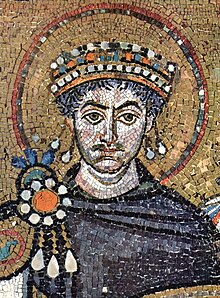
Justinian I, who assumed the throne in 527, oversaw a period of Byzantine expansion into former Roman territories. Justinian, the son of an
The western conquests began in 533, as Justinian sent his general
Nevertheless, the Ostrogoths were soon reunited under the command of
In the east, Roman–Persian Wars continued until 561 when Justinian's and Khusro's envoys agreed on a 50-year peace. By the mid-550s, Justinian had won victories in most theatres of operation, with the notable exception of the Balkans, which were subjected to repeated incursions from the Slavs. In 559, the Empire faced a great invasion of Kutrigurs and Sclaveni. Justinian called Belisarius out of retirement, but once the immediate danger was over, the emperor took charge himself. The news that Justinian was reinforcing his Danube fleet made the Kutrigurs anxious, and they agreed to a treaty which gave them a subsidy and safe passage back across the river.[26]
Justinian became universally famous because of his legislative work, remarkable for its sweeping character.
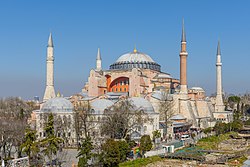
During the 6th century, the traditional
After Justinian died in 565, his successor,
Heraclian dynasty and shrinking borders
After Maurice's murder by
In an attempt to heal the doctrinal divide between
Heraclius did succeed in establishing a dynasty, and his descendants held onto the throne, with some interruption, until 711. Their reigns were marked both by major external threats, from the west and the east, which reduced the territory of the empire to a fraction of its 6th-century extent, and by significant internal turmoil and cultural transformation.
The Arabs, now firmly in control of Syria and the Levant, sent frequent raiding parties deep into Asia Minor, and in 674–678 laid siege to Constantinople itself. The Arab fleet was finally repulsed through the use of Greek fire, and a thirty-years' truce was signed between the Empire and the Umayyad Caliphate.[48] However, the Anatolian raids continued unabated, and accelerated the demise of classical urban culture, with the inhabitants of many cities either refortifying much smaller areas within the old city walls, or relocating entirely to nearby fortresses.[49] Constantinople itself dropped substantially in size, from 500,000 inhabitants to just 40,000–70,000, and, like other urban centers, it was partly ruralised. The city also lost the free grain shipments in 618, after Egypt fell first to the Persians and then to the Arabs, and public wheat distribution ceased.[50] The void left by the disappearance of the old semi-autonomous civic institutions was filled by the theme system, which entailed the division of Asia Minor into "provinces" occupied by distinct armies which assumed civil authority and answered directly to the imperial administration. This system may have had its roots in certain ad hoc measures taken by Heraclius, but over the course of the 7th century it developed into an entirely new system of imperial governance.[51]
The withdrawal of massive numbers of troops from the Balkans to combat the Persians and then the Arabs in the east opened the door for the gradual southward expansion of
The one Byzantine city that remained relatively unaffected, despite a significant drop in population and at least two outbreaks of the plague, was Constantinople.
The 7th century was a period of radical transformation. The empire which had once stretched from Spain to Jerusalem was now reduced to Anatolia,

There also seem to
The period of internal instability
Isaurian dynasty and Iconoclasm

Built in reign of Anastasius I (491–518 AD), the Chalke Gates were meant to celebrate the Byzantium victory in the
Leo III's son, Constantine V (741–775 AD), won noteworthy victories in northern Syria, and also thoroughly undermined Bulgar strength during his reign. Like his father, Constantine V, Leo IV (775–780 AD) was an iconoclast.[79] However, Leo IV was dominated by his wife Irene who tended toward iconodulism and supported religious statues and images. Upon the death of Leo IV in 780 AD, his 10-year-old son, Constantine VI (780–797 AD) succeeded to the Byzantine throne under the regency of his mother Irene. However, before Constantine VI could come of age and rule in his own right, his mother usurped the throne for herself.[79] Irene (797–802 AD) reinstated a policy of iconodulism and in 787 AD at the Council of Nicaea, iconodulism was made official church policy, thus revoking Leo III's official policy of 730 AD. Accordingly, the period of time called the "first iconoclasm" dating from 726 AD through 787, came to an end. An intervening period of iconodulism was initiated which would last through the reigns of Irene and her successors, Nikephoros I (802–811 AD); Staurakios (811 AD) and Michael I Rhangabe (811–813 AD).
In the beginning of the 9th century the Arabs captured Crete, and successfully attacked Sicily, but on 3 September 863, general
As noted above, the 8th and 9th centuries were also dominated by controversy and religious division over
Irene made determined efforts to stamp out iconoclasm everywhere in the Empire including within the ranks of the army.[81] During Irene's reign the Arabs were continuing to raid into and despoil the small farms of the Anatolian section of the Empire. These small farmers of Anatolia owed a military obligation to the Byzantine throne. Indeed, the Byzantine army and the defense of the Empire was largely based on this obligation and the Anatolian farmers. The iconodule policy drove these farmers out of the army and thus off their farms. Thus, the army was weakened and was unable to protect Anatolia from the Arab raids.[82] Many of the remaining farmers of Anatolia were driven from the farm to settle in the city of Byzantium, thus, further reducing the army's ability to raise soldiers. Additionally, the abandoned farms fell from the tax rolls and reduced the amount of income that government received. These farms were taken over by the largest land owner in the Byzantine Empire—the monasteries. To make the situation even worse, Irene had exempted all monasteries from all taxation.
Given the financial ruin into which the Empire was headed, it was no wonder, then, that Irene was, eventually, deposed by her own
Nicephorus I (802–811 AD) was of Arab extraction. Although he moved immediately to set the Byzantine economy on a better financial footing by countermanding Irene's tax exemptions and to strengthen the army, by drafting the destitute small land holders, Nicephorus I, nonetheless, continued Irene's iconodule policy.[83] Nicephorus I was killed in 811 AD, while battling the Bulgars under their King Krum. Nicephorous' son and successor to the throne, Stauracius (811 AD), was severely wounded in the same battle. Stauracius died just six months after the battle. Nicephorus I's daughter, Procopia, was married to Michael Rhangabe, who now became Emperor as Michael I.[84]
Irene is said to have endeavored to negotiate a marriage between herself and Charlemagne, but, according to Theophanes the Confessor, the scheme was frustrated by Aetios, one of her favourites.[85] During the reign of Michael I (811–813 AD) foreign policy initiatives involving Charlemagne, again, took front stage. Since being crowned by Pope Leo III as Emperor on Christmas Day, 800 AD in Rome, Charlemagne had been laying claims to the Eastern Empire. Nicephorus I had refused to recognise Charlemagne's position and had merely ignored these claims by Charlemagne.[86] This inflexible policy by Nicephorus I had resulted in a naval war with Franks which indirectly led to the official separation of the city of Venice from the Byzantine Empire. (In fact, Venice had been acting under a "de facto" independence since 727 AD. This de facto independence was recognised by the Pax Nicephori of 802 AD. Nonetheless, despite this de facto independence, Venice had officially remained a part of the Byzantine Empire until 811 AD.)
The threat posed by the Bulgars under their King Krum which had become very evident in the crisis of 811 AD forced Michael I to reverse the policy of non-recognition of Charlemagne. As noted above, Nicephorus I had died in battle in 811 AD and his son, Stauracious, had been severely wounded in the same battle and died a short time later in 811 AD. The Bulgar threat required Michael I to reverse Nicephorus' policy and recognise Charlemagne and open peace negotiations with him in order to avoid war with both the Franks under Charlemagne and with the Bulgars at the same time. This reversal of policy and the agreement reached with Charlemagne had long range implications. Under the terms of the treaty between Charlemagne and the Byzantine Empire, Charlemagne received recognition of his imperial title to the lands he held in the west and, in exchange, Charlemagne dropped all his claims to the throne or any part of the Byzantine Empire.[87] This treaty of 811 AD was a watershed. Until this date, despite the centuries of separation, there had always remained the forlorn hope that the two parts of the old Roman Empire might eventually be reconciled. From 811 AD on this hope was finally given up. There was, no longer any hope or idea of merging the two parts of the old Roman Empire.
Michael I had been forced into this treaty with Charlemagne because of the Bulgar threat. His failure to achieve success against the Bulgar would cause a revolt against him which would end his reign in 813 AD. The military would rise up against Michael I. The leader of this revolt was the Armenian commander of the army who would take the throne under the name of Leo V.[88]
Amorian (Phrygian) dynasty
In 813
However, iconoclasm may have been influential in the rise of feudalism in the Byzantine Empire. Feudalism is characterized and, indeed, defined as the decline of central governmental power as power is handed over to private, local, large landholders. In any given locality these private individuals become the new governmental power over the common people working and living in the area. The private land holders owe only a duty of military service to the central government when they are called upon by the central authority. This duty is called patronage and in exchange for the patronage, the land holders are granted immunity in their rule over the locality.[91] Ever since the reign of Emperor Severus Alexander (222–235 AD), lands on the frontiers of the Roman Empire which had been taken from enemies, were granted to Roman soldiers and their heirs on the condition that the duty for military service to the Emperor would also be hereditary and on the condition that the lands would never be sold, but would remain in the family.[92] This was the true beginning of feudalism in the Byzantine Empire. With the advent of iconoclasm, many monasteries were despoiled and church lands were seized by the Emperor. These lands were handed over to private individuals. Patronage for these individuals was once again the duty of military service to the Emperor. As noted above, some of these lands were restored to the monasteries under Empress Irene. However, feudalism had really been allowed to take root by the private control of these monastery lands.
Macedonian dynasty and resurgence

The Byzantine Empire reached its height under the Macedonian emperors (of Greek descent) of the late 9th, 10th, and early 11th centuries, when it gained control over the Adriatic Sea, southern Italy, and all of the territory of tsar Samuel of Bulgaria. The cities of the empire expanded, and affluence spread across the provinces because of the new-found security. The population rose, and production increased, stimulating new demand while also helping to encourage trade. Culturally, there was considerable growth in education and learning. Ancient texts were preserved and patiently re-copied. Byzantine art flourished, and brilliant mosaics graced the interiors of the many new churches.[93] Though the empire was significantly smaller than during the reign of Justinian, it was also stronger, as the remaining territories were less geographically dispersed and more politically and culturally integrated[citation needed].
Internal developments
Although traditionally attributed to
Wars against the Muslims

By 867, the empire had re-stabilised its position in both the east and the west, and the efficiency of its defensive military structure enabled its emperors to begin planning wars of reconquest in the east.[98] The process of reconquest began with variable fortunes. The temporary reconquest of Crete (843 AD) was followed by a crushing Byzantine defeat on the Bosporus, while the emperors were unable to prevent the ongoing Muslim conquest of Sicily (827–902 AD).[99] Using present day Tunisia as their launching pad, the Muslims conquered Palermo in 831 AD, Messina in 842 AD, Enna in 859 AD, Syracuse in 878 AD, Catania in 900 AD and the final Byzantine stronghold, the fortress of Taormina, in 902 AD.
These drawbacks were later counterbalanced by a victorious expedition against
In the early years of Basil I's reign, Arab raids on the coasts of Dalmatia were successfully repelled, and the region once again came under secure Byzantine control. This enabled Byzantine missionaries to penetrate to the interior and convert the
Under Michael's son and successor, Leo VI the Wise, the gains in the east against the now weak Abbasid Caliphate continued. However, Sicily was lost to the Arabs in 902, and in 904 Thessaloniki, the Empire's second city, was sacked by an Arab fleet. The weakness of the Empire in the naval sphere was quickly rectified so that a few years later a Byzantine fleet had re-occupied Cyprus, lost in the 7th century, and also stormed Laodicea in Syria. Despite this revenge, the Byzantines were still unable to strike a decisive blow against the Muslims, who inflicted a crushing defeat on the imperial forces when they attempted to regain Crete in 911.[101]
The death of the Bulgarian tsar
The soldier-emperors
Wars against the Bulgarians
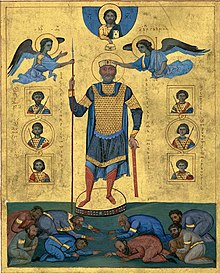
The traditional struggle with the
Leo the Wise died in 912, and hostilities soon resumed as Simeon marched to Constantinople at the head of a large army.[108] Though the walls of the city were impregnable, the Byzantine administration was in disarray and Simeon was invited into the city, where he was granted the crown of basileus (emperor) of Bulgaria and had the young emperor Constantine VII marry one of his daughters. When a revolt in Constantinople halted his dynastic project, he again invaded Thrace and conquered Adrianople.[109] The Empire now faced the problem of a powerful Christian state within a few days' marching distance from Constantinople, as well as having to fight on two fronts.[101]
A great imperial expedition under
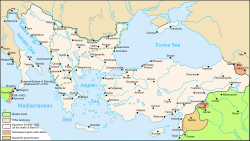
Bulgarian resistance revived under the leadership of the Cometopuli dynasty, but the new emperor Basil II (reigned 976–1025 AD) made the submission of the Bulgarians his primary goal. Basil's first expedition against Bulgaria however resulted in a humiliating defeat at the Gates of Trajan. For the next few years, the emperor would be preoccupied with internal revolts in Anatolia, while the Bulgarians expanded their realm in the Balkans. The war was to drag on for nearly twenty years. The Byzantine victories of Spercheios and Skopje decisively weakened the Bulgarian army, and in annual campaigns, Basil methodically reduced the Bulgarian strongholds. Eventually, at the Battle of Kleidion in 1014 the Bulgarians were completely defeated.[112] The Bulgarian army was captured, and it is said that 99 out of every 100 men were blinded, with the remaining hundredth man left with one eye so as to lead his compatriots home. When Tsar Samuil saw the broken remains of his once gallant army, he died of shock. By 1018, the last Bulgarian strongholds had surrendered, and the country became part of the empire. This epic victory restored the Danube frontier, which had not been held since the days of the emperor Heraclius.[93]
Relations with Kiev Rus
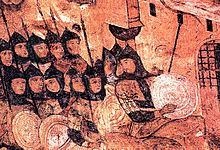
Between 850 and 1100 the Empire developed a mixed relationship with the new state of
employed many architects and artists to work on numerous cathedrals and churches around Rus, expanding the Byzantine influence even further.Kiev Princes were often married into the Byzantine imperial family and Constantinople often employed Princes' armies, most notably
states the marriage was in exchange for the Rus conversion to Orthodoxy, the creation of the Varangian Guard, although significant, was only a by-product of this exchange.These relationships were not always friendly. During those three hundred years
The Byzantine influence on
The climax
The Roman Empire then stretched from Armenia in the east, to Calabria in Southern Italy in the west.[93] Many successes had been achieved, ranging from the conquest of Bulgaria, to the annexation of parts of Georgia and Armenia, to the total annihilation of an invading force of Egyptians outside Antioch. Yet even these victories were not enough; Basil considered the continued Arab occupation of Sicily to be an outrage. Accordingly, he planned to reconquer the island, which had belonged to the empire for over 300 years (c536 – c. 900). However, his death in 1025 put an end to the project.[93]

Leo VI achieved the complete codification of Byzantine law in Greek. This monumental work of 60 volumes became the foundation of all subsequent Byzantine law and is still studied today. Leo also reformed the administration of the Empire, redrawing the borders of the administrative subdivisions (the Themata, or "Themes") and tidying up the system of ranks and privileges, as well as regulating the behavior of the various trade guilds in Constantinople. Leo's reform did much to reduce the previous fragmentation of the Empire, which henceforth had one center of power, Constantinople. However, the increasing military success of the Empire greatly enriched and empowered the provincial nobility with respect to the peasantry, who were essentially reduced to a state of serfdom.
Under the Macedonian emperors, the city of Constantinople flourished, becoming the largest and wealthiest city in Europe, with a population of approximately 400,000 in the 9th and 10th centuries.[116] During this period, the Byzantine Empire employed a strong civil service staffed by competent aristocrats that oversaw the collection of taxes, domestic administration, and foreign policy. The Macedonian emperors also increased the Empire's wealth by fostering trade with Western Europe, particularly through the sale of silk and metalwork.[117]
The 11th century was also momentous for its religious events. In 1054, relations between Greek-speaking Eastern and Latin-speaking Western traditions within the Christian Church reached a terminal crisis. Although there was a formal declaration of institutional separation, on 16 July, when three papal legates entered the Hagia Sophia during
Crisis and fragmentation
Byzantium soon fell into a period of difficulties, caused to a large extent by the undermining of the theme system and the neglect of the military.

At the same time, the Empire was faced with new, ambitious enemies. Byzantine provinces in southern Italy faced the
It was in Asia Minor, however, that the greatest disaster would take place. The
In the meantime, the Byzantine presence in southern Italy had been wiped out by the Normans. Reggio, the capital of the tagma of Calabria, was captured by Robert Guiscard in 1060. At the time the Byzantines controlled only a few of coastal cities in Apulia. Otranto fell in 1068, the same year in which the siege of Bari (the capital of the catepanate of Italy) begun. After the Byzantines had been defeated in a series of battles, and any attempt to relief the city had failed, Bari was surrendered in April 1071. This event ended the Byzantine presence in southern Italy.[122]
Komnenian dynasty and the crusaders
Komnenian dynasty and the crusaders

During the Komnenian, or Comnenian, period from about 1081 to about 1185, the five emperors of the Komnenos dynasty (Alexios I, John II, Manuel I, Alexios II, and Andronikos I) presided over a sustained, though ultimately incomplete, restoration of the military, territorial, economic, and political position of the Byzantine Empire.[123] Although the Seljuk Turks occupied the heartland of the Empire in central Anatolia, most Byzantine military efforts during this period were directed against Western powers, particularly the Normans.[123]
The Empire under the Komnenoi played a key role in the history of the Crusades in the Holy Land, which Alexios I had helped bring about, while also exerting enormous cultural and political influence in Europe, the Near East, and the lands around the Mediterranean Sea under John and Manuel. Contact between Byzantium and the "Latin" West, including the Crusader states, increased significantly during the Komnenian period. Venetian and other Italian traders became resident in large numbers in Constantinople and the empire (there were an estimated 60,000 Latins in Constantinople alone, out of a population of three to four hundred thousand), and their presence together with the numerous Latin mercenaries who were employed by Manuel helped to spread Byzantine technology, art, literature and culture throughout the Latin West, while also leading to a flow of Western ideas and customs into the Empire.[124]
In terms of prosperity and cultural life, the Komnenian period was one of the peaks in Byzantine history,[125] and Constantinople remained the leading city of the Christian world in size, wealth, and culture.[126] There was a renewed interest in classical Greek philosophy, as well as an increase in literary output in vernacular Greek.[127] Byzantine art and literature held a pre-eminent place in Europe, and the cultural impact of Byzantine art on the west during this period was enormous and of long lasting significance.[128]
Alexios I and the First Crusade
After Manzikert, a partial recovery (referred to as the Komnenian restoration) was made possible by the Komnenian dynasty.[129] The first Komnenian emperor was Isaac I (1057–1059), after which the Doukas dynasty held power (1059–81). The Komnenoi attained power again under Alexios I in 1081. From the outset of his reign, Alexios faced a formidable attack by the Normans under Robert Guiscard and his son Bohemund of Taranto, who captured Dyrrhachium and Corfu, and laid siege to Larissa in Thessaly. Robert Guiscard's death in 1085 temporarily eased the Norman problem. The following year, the Seljuq sultan died, and the sultanate was split by internal rivalries. By his own efforts, Alexios defeated the Pechenegs; they were caught by surprise and annihilated at the Battle of Levounion on 28 April 1091.[19]
Having achieved stability in the West, Alexios could turn his attention to the severe economic difficulties and the disintegration of the Empire's traditional defences.[130] However, he still did not have enough manpower to recover the lost territories in Asia Minor and to advance against the Seljuks. At the Council of Piacenza in 1095, envoys from Alexios spoke to Pope Urban II about the suffering of the Christians of the East, and underscored that without help from the West they would continue to suffer under Muslim rule.[131]

Urban saw Alexios' request as a dual opportunity to cement Western Europe and reunite the Eastern Orthodox Churches with the Roman Catholic Church under his rule.[131] On 27 November 1095, Pope Urban II called together the Council of Clermont, and urged all those present to take up arms under the sign of the Cross and launch an armed pilgrimage to recover Jerusalem and the East from the Muslims. The response in Western Europe was overwhelming.[19]
Alexios had anticipated help in the form of mercenary forces from the West, but he was totally unprepared for the immense and undisciplined force which soon arrived in Byzantine territory. It was no comfort to Alexios to learn that four of the eight leaders of the main body of the Crusade were Normans, among them Bohemund. Since the crusade had to pass through Constantinople, however, the Emperor had some control over it. He required its leaders to swear to restore to the empire any towns or territories they might conquer from the Turks on their way to the Holy Land. In return, he gave them guides and a military escort.[132]
Alexios was able to recover a number of important cities and islands, and in fact much of western Asia Minor. Nevertheless, the crusaders believed their oaths were invalidated when Alexios did not help them during the siege of Antioch (he had in fact set out on the road to Antioch but had been persuaded to turn back by Stephen of Blois, who assured him that all was lost and that the expedition had already failed).[133] Bohemund, who had set himself up as Prince of Antioch, briefly went to war with the Byzantines, but he agreed to become Alexios' vassal under the Treaty of Devol in 1108, which marked the end of the Norman threat during Alexios' reign.[134]
John II, Manuel I and the Second Crusade

Alexios' son
John's chosen heir was his fourth son,
In the east, however, Manuel suffered a major defeat at the Battle of Myriokephalon, in 1176, against the Turks. Yet the losses were quickly made good, and in the following year Manuel's forces inflicted a defeat upon a force of "picked Turks".[146] The Byzantine commander John Vatatzes, who destroyed the Turkish invaders at the Battle of Hyelion and Leimocheir, not only brought troops from the capital but also was able to gather an army along the way; a sign that the Byzantine army remained strong and that the defensive program of western Asia Minor was still successful.[147]
12th century Renaissance
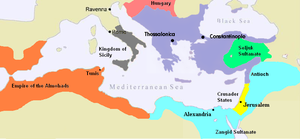
John and Manuel pursued active military policies, and both deployed considerable resources on sieges and on city defenses; aggressive fortification policies were at the heart of their imperial military policies.[148] Despite the defeat at Myriokephalon, the policies of Alexios, John and Manuel resulted in vast territorial gains, increased frontier stability in Asia Minor, and secured the stabilization of the empire's European frontiers. From c.1081 to c.1180, the Komnenian army assured the empire's security, enabling Byzantine civilization to flourish.[149]
This allowed the Western provinces to achieve an economic revival which continued until the close of the century. It has been argued that Byzantium under the Komnenian rule was more prosperous than at any time since the Persian invasions of the 7th century. During the 12th century population levels rose and extensive tracts of new agricultural land were brought into production. Archaeological evidence from both Europe and Asia Minor shows a considerable increase in the size of urban settlements, together with a notable upsurge in new towns. Trade was also flourishing; the Venetians, the
In artistic terms, there was a revival in mosaic, and regional schools of architecture began producing many distinctive styles that drew on a range of cultural influences.[151] During the 12th century the Byzantines provided their model of early humanism as a renaissance of interest in classical authors. In Eustathius of Thessalonica Byzantine humanism found its most characteristic expression.[152]
Decline and disintegration
Dynasty of the Angeloi and Third Crusade
Manuel's death on 24 September 1180 left his 11-year-old son
| "Whatever paper might be presented to the Emperor (Alexios III) for his signature, he signed it immediately; it did not matter that in this paper there was a senseless agglomeration of words, or that the supplicant demanded that one might sail by land or till the sea, or that mountains should be transferred into the middle of the seas or, as a tale says, that Athos should be put upon Olympus." |
| Nicetas Choniates[155] |
This troubled succession weakened the dynastic continuity and solidarity on which the strength of the Byzantine state had come to rely.[156] The new emperor was a man of astounding contrasts.[156] Handsome and eloquent, Andronikos was at the same time known for his licentious exploits.[157] Energetic, able and determined, he had been called a "true Komnenos".[153] However, he was also capable of terrifying brutality, violence and cruelty.[158]
Andronikos began his reign well; in particular, the measures he took to reform the government of the empire have been praised by historians. According to George Ostrogorsky, Andronikos was determined to root out corruption: Under his rule the sale of offices ceased; selection was based on merit, rather than favoritism; officials were paid an adequate salary so as to reduce the temptation of bribery. In the provinces Andronikos' reforms produced a speedy and marked improvement.[156] The people felt the severity of his laws, but acknowledged their justice, and found themselves protected from the rapacity of their superiors.[156] Andronikos' efforts to rein in the oppressive tax collectors and officials of the empire did much to alleviate the lot of the peasantry, but his attempt to check the power of the nobility was considerably more problematic. The aristocrats were infuriated against him, and to make matters worse, Andronikos seems to have become increasingly unbalanced; executions and violence became increasingly common, and his reign turned into a reign of terror.[159] Andronikos seemed almost to seek the extermination of the aristocracy as a whole. The struggle against the aristocracy turned into wholesale slaughter, while the emperor resorted to ever more ruthless measures to shore up his regime.[160]
Despite his military background, Andronikos failed to deal with
The reign of Isaac II, and, still more, that of his brother
Fourth Crusade
In 1198,
After the death of
| "None of you should therefore dare to assume that it is permissible for you to seize or to plunder the land of the Greeks, even though the latter may be disobedient to the Apostolic See, or on the grounds that the Emperor of Constantinople has deposed and even blinded his brother and usurped the imperial throne. For though this same emperor and the men entrusted to his rule may have sinned, both in these and in other matters, it is not for you to judge their faults, nor have you assumed the sign of the cross to punish this injury; rather you specifically pledged your self to the duty of avenging the insult to the cross." |
| Innocent III to Baldwin IX, Count of Flanders, and Louis I, Count of Blois (Ferentino, summer 1203, c. 20 June).[171]
|
When in late November 1203 Alexios IV announced that his promises were hard to keep as the empire was short on funds (he had managed to pay roughly half of the promised amount of 200,000 silver marks, and could not fulfil his promise that he would cover the Venetians' rent of the fleet for the crusaders.

The crusaders again took the city on 13 April 1204, and Constantinople was subjected to pillage and massacre by the rank and file for three days. Many priceless icons, relics, and other objects later turned up in
Fall
Empire in exile
After the sack of Constantinople in 1204 by Latin
Reconquest of Constantinople
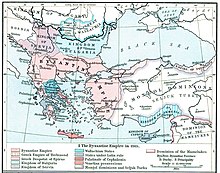

The Empire of Nicaea, founded by the Laskarid dynasty, managed to reclaim Constantinople from the Latins in 1261 and defeat Epirus. This led to a short-lived revival of Byzantine fortunes under Michael VIII Palaiologos, but the war-ravaged empire was ill-equipped to deal with the enemies that now surrounded it. In order to maintain his campaigns against the Latins, Michael pulled troops from Asia Minor, and levied crippling taxes on the peasantry, causing much resentment.[179] Massive construction projects were completed in Constantinople to repair the damages of the Fourth Crusade, but none of these initiatives was of any comfort to the farmers in Asia Minor, suffering raids from fanatical ghazis.
Rather than holding on to his possessions in Asia Minor, Michael chose to expand the Empire, gaining only short-term success. To avoid another sacking of the capital by the Latins, he forced the Church to submit to Rome, again a temporary solution for which the peasantry hated Michael and Constantinople.[180] The efforts of Andronikos II and later his grandson Andronikos III marked Byzantium's last genuine attempts in restoring the glory of the empire. However, the use of mercenaries by Andronikos II would often backfire, with the Catalan Company ravaging the countryside and increasing resentment towards Constantinople.[181]
Late Civil Wars
Societal infighting weakened the military power of the Byzantine Empire in the 14th century, including two major civil wars beginning in 1321 and 1341. The civil war of 1321–28 was led by a grandson of the Byzantine Emperor

Following the death of Andronikos III in 1341 another civil war broke out,
The civil war led to the exploitation of the Byzantine Empire by the emerging
Cantacuzenus conquered Constantinople in 1347 and ended the civil war.
Rise of the Ottomans and fall of Constantinople
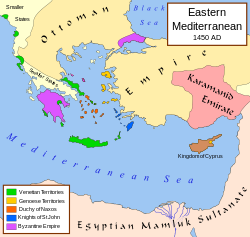
Things went worse for Byzantium, when, during the civil war, an earthquake at Gallipoli in 1354 devastated the fort, allowing the Turks the very next day to cross into Europe.[189] By the time the Byzantine civil war had ended, the Ottomans had defeated the Serbians and subjugated them as vassals. Following the Battle of Kosovo, much of the Balkans became dominated by the Ottomans.[190]
The Emperors appealed to the west for help, but the Pope would only consider sending aid in return for a reunion of the Eastern Orthodox Church with the See of Rome. Church unity was considered, and occasionally accomplished by imperial decree, but the Eastern Orthodox citizenry and clergy intensely resented Roman authority and the Latin Church.[191] Some Western troops arrived to bolster the Christian defence of Constantinople, but most Western rulers, distracted by their own affairs, did nothing as the Ottomans picked apart the remaining Byzantine territories.[192]
Constantinople by this stage was underpopulated and dilapidated. The population of the city had collapsed so severely that it was now little more than a cluster of villages separated by fields. On 2 April 1453, the Sultan's army of some 80,000 men and large numbers of irregulars laid siege to the city.
Aftermath

By the time of the fall of Constantinople, the only remaining territory of the Byzantine Empire was the Despotate of the Morea, which was ruled by brothers of the last Emperor and continued on as a tributary state to the Ottomans. Incompetent rule, failure to pay the annual tribute and a revolt against the Ottomans finally led to Mehmed II's invasion of Morea in May 1460; he conquered the entire Despotate by the summer. The Empire of Trebizond, which had split away from the Byzantine Empire in 1204, became the last remnant and last de facto successor state to the Byzantine Empire. Efforts by the Emperor David to recruit European powers for an anti-Ottoman crusade provoked war between the Ottomans and Trebizond in the summer of 1461. After a monthlong siege, David surrendered the city of Trebizond on August 14, 1461. With the fall of Trebizond, the Principality of Theodoro soon followed by the end of 1475, the last remnant of the Roman Empire was extinguished.
The nephew of the last Emperor, Constantine XI,
Vlachs and Romanians are speaking a Romance language and they regard themselves as the descendants of the ancient Romans who conquered the South East parts of Europe. Vlach is an exonym, as the Vlachs used various words derived from “romanus” to refer to themselves: români, rumâni, rumâri, aromâni, arumâni, armâni etc. All Balkan countries (Greeks, Bulgarians, Serbs, Macedonians, Montenegrins, Bosniaks, Kosovars, Albanians, Croats, Slovenians and Turks) were influenced by the Vlachs from the early medieval times. Today the Vlachs do not have a country of their own.
At his death, the role of the emperor as a patron of
Annotations
- ^ The first instance of the designation "New Rome" in an official document is found in the canons of the First Council of Constantinople (381), where it is used to justify the claim that the patriarchal seat of Constantinople is second only to that of Rome.[2]
Notes
- ^ Treadgold 1997, p. 847.
- ^ Benz 1963, p. 176.
- ^ Ostrogorsky 1969, pp. 105–107, 109; Norwich 1998, p. 97; Haywood 2001, pp. 2.17, 3.06, 3.15.
- ^ Millar 2006, pp. 2, 15; James 2010, p. 5; Freeman 1999, pp. 431, 435–37, 459–62; Baynes & Moss 1948, p. xx; Ostrogorsky 1969, p. 27; Kaldellis 2007, pp. 2–3; Kazhdan & Constable 1982, p. 12; Norwich 1998, p. 383.
- ^ John Haldon, Warfare, State And Society In The Byzantine World 560–1204, p.47
- ^ Bury (1923), 1
* Fenner, Economic Factors Archived 2008-06-18 at the Wayback Machine - ^ a b c Bury (1923), 1
- MiB)
- ^ Eusebius, IV, lxii
- MiB)
- ^ Bury (1923), 1
* Esler (2000), 1081 - ^ Esler (2000), 1081
- ^ Carnuntum Jahrbuch 1998 page 25
- ^ Bury (1923), 25–26
- ISBN 978-973-8966-70-3, p.64 -126
- ISBN 978-0-674-16531-1. p 250.
- ^ Esler (2000), 1081
* Mousourakis (2003), 327–328 - ^ Bury (1923), 163
- ^ a b c d e f g h "Byzantine Empire". Encyclopædia Britannica.
- ^ Nathan, Theodosius II (408–450 AD)
- ^ Treadgold (1995), 193
- ^ Alemany (2000), 207
* Treadgold (1997), 184 - ^ Treadgold (1997), 152–155
- ^ Cameron (2000), 553
- ^ Grierson (1999), 17
- ^ a b c Evans, Justinian (AD 527–565)
- ^ Gregory 2010, p. 145.
- ^ Evans 2005, p. xxv.
- ^ Bury 1923, pp. 180–216; Evans 2005, pp. xxvi, 76.
- ^ Maas 2005, p. 278; Treadgold 1997, p. 187.
- ^ Procopius, IX
- ^ Bury (1923), 236–258
- ^ Bury (1923), 259–281
- ^ Bury (1923), 286–288
- ^ Vasiliev, The Legislative Work of Justinian and Tribonian
- ^ Vasiliev, The Ecclesiastical Policy of Justinian
- ^ Bray (2004), 19–47
* Haldon (1997), 110–111
* Treadgold (1997), 196–197 - ^ Louth 2005, pp. 113–115; Nystazopoulou-Pelekidou 1970, passim; Treadgold 1997, pp. 231–232.
- ^ Foss (1975), 722
- ^ Haldon (1997), 41
* Speck (1984), 178 - ^ Haldon (1997), 42–43
- ^ Grabar (1984), 37
* Cameron (1979), 23 - ^ Cameron (1979), 5–6, 20–22
- ^ Haldon (1997), 46
* Baynes (1912), passim
* Speck (1984), 178 - ^ Foss (1975), 746–47
- ^ Haldon (1997), 50
- ^ Haldon (1997), 49–50
- ^ Haldon 1990, pp. 61–62.
- ^ Haldon 1990, pp. 102–114; Laiou & Morisson 2007, p. 47.
- ^ Laiou & Morisson 2007, pp. 38–42, 47; Wickham 2009, p. 260.
- ^ Haldon 1990, pp. 208–215; Kaegi 2003, pp. 236, 283.
- ^ Haldon (1997), 43–45, 66, 114–115
- ^ Haldon (1997), 66–67
- ^ Haldon (1997), 71
- ^ Haldon (1997), 115–116
- ^ Haldon (1997), 56–59
- ^ Haldon (1997), 59–61
- ^ Haldon (1997), 53, 61, 68–69, 74
- ^ Haldon (1997), 70–78, 169–171
* Haldon (2004), 216–217
* Kountoura-Galake (1996), 62–75 - ^ Cameron (1992)
- ^ Kitzinger (1976), 195
- ^ Haldon (1997), 251
- ISBN 978-0-330-49136-5.
- ^ Durant (2011), p. 118.
- ^ LIVUS (28 October 2010). "Silk Road", Articles of Ancient History. Retrieved on 22 September 2016.
- ^ Yule (1915), pp 29–31; see also footnote #4 on p. 29; footnote #2 on p. 30; and footnote #3 on page 31.
- ^ Yule (1915), p. 30 and footnote #2.
- ^ a b c d Hirth (2000) [1885], East Asian History Sourcebook. Retrieved 2016-09-22.
- ^ Henry Yule expressed some amazement that even the name of the Byzantine negotiator "Yenyo" (i.e. the patrician Ioannes Petzigaudias) was mentioned in Chinese sources, an envoy who was unnamed in Edward Gibbon's account of the man sent to Damascus to hold a parley with the Umayyads, followed a few years later by the increase of tributary demands on the Byzantines; see Yule (1915), pp 48–49; and for the brief summary of Edward Gibbon's account, see also footnote #1 on p. 49.
- ^ Yule (1915), pp 54–55.
- ^ Schafer (1985), pp 10, 25–26.
- ^ Yule (1915), pp 55–56.
- ^ Sezgin et al. (1996), p. 25.
- ^ John Julius Norwich, Byzantium: The Early Centuries (Alfred A. Knoft Pub.: New York, 1996) p. 353.
- ^ a b John Julius Norwich, Byzantium: The Early Centuries, p. 353.
- ^ a b John Julius Norwich, Byzantium: The Early Centuries, p. 355.
- ^ John Julius Norwich, Byzantium: The Apogee (Alfred a. Knopf Pub.: New York, 2001) pp. 1–2.
- ^ John Julius Norwich, Byzantium: The Apogee (Alfred A. Knopf Pub.: New York, 2001) p. 2.
- ^ a b John Julius Norwich, Byzantium: The Apogee, p. 2.
- Encyclopaedia The Helios.
- ^ John Jacob Norwich, Byzantium: The Apogee, p. 4.
- ^ a b John Julius Norwich, Byzantium: The Apogee, p. 4.
- ^ John Julius Norwich, Byzantium: The Apogee, p. 5.
- ^ John Julius Norwich, Byzantium: The Apogee, p. 13.
- ^ Garland 1999, p. 89
- ^ John Julius Norwich, Byzantium: The Apogee, pp. 11–12.
- ^ John Julius Norwich, History of Venice, p. 14.
- ^ A. A. Vasiliev, History of the Byzantine Empire: 324–1453 (University of Wisconsin Press: Madison, 1952) pp. 271–272.
- ^ John Julius Norwich, Byzantium: The Apogee, pp. 21–22.
- ^ Parry 1996, pp. 11–15
- ^ A. A. Vasiliev, History of the Byzantine Empire: 324–1453, p. 564.
- ^ A.A. Vasiliev, History of the Byzantine Empire, p. 566.
- ^ a b c d e f Norwich (1998)
- ^ Treadgold (1991)
- ^ A. A. Vasiliev, History of the Byzantine Empire: 324–1453 (University of Wisconsin Press: Madison, 1952) p. 275.
- ^ Robert S. Hoyt & Stanley Chodorow, Europe in the Middle Ages (Harcourt, Brace & Jovanovich Inc.: New York, 1976) p. 313.
- ^ A. A. Vasiliev, History of the Byzantine Empire, p. 276.
- ^ A. A. Vasiliev, History of the Byzantine Empire: 324–1453, pp. 215–126.
- ^ John Julius Norwich, Byzantium: The Apogee (Alfred A. Knopf: New York, 2001) p. 57.
- ^ Karlin-Heyer 1967, p. 24.
- ^ a b c Browning 1992, p. 101.
- ^ Browning 1992, p. 107.
- ^ C. M. Woodhouse, Modern Greece: A Short History (Faber & Faber Pub.: London, 1991) p. 54.
- ^ John Julius Norwich, Byzantium, The Apogee pp. 152–153.
- ^ A. A. Vasiliev, History of the Byzantine Empire: 324–1453 p. 308.
- ^ A. A. Vasiliev, History of the Byzantine Empire: 324–1453 pp. 310–311.
- ^ Browning 1992, p. 100.
- ^ Browning 1992, pp. 102–103.
- ^ Browning 1992, pp. 103–105.
- ^ Browning 1992, pp. 106–107.
- ^ Browning 1992, pp. 112–113.
- ^ Angold 1997
- ^ A. A. Vasiliev, History of the Byzantine Empire: 324–1453, p. 320.
- ^ A. A. Vasiliev, History of the Byzantine Empire: 324–1453, p. 321.
- ^ Prince Oleg's Campaign Against Constantinople
- ^ Laiou & Morisson 2007, pp. 130–131; Pounds 1979, p. 124.
- ^ Duiker & Spielvogel 2010, p. 317.
- ^ Treadgold (1997), 548–549
- ^ a b Markham, The Battle of Manzikert Archived 2007-05-13 at the Wayback Machine
- ^ Vasiliev, Relations with Italy and Western Europe
- ^ "Byzantine Empire". Encyclopædia Britannica. 2002.
* Markham, The Battle of Manzikert Archived 2007-05-13 at the Wayback Machine - ^ Ravegnani, Giorgio (2004). I bizantini in Italia (in Italian). Bologna: l Mulino. pp. 201–212.
- ^ a b Browning 1992, p. 190.
- ^ Cameron 2006, pp. 46.
- ^ Cameron 2006, pp. 42.
- ^ Cameron 2006, pp. 47.
- ^ Browning 1992, pp. 198–208.
- ^ Browning 1992, p. 218.
- ^ Magdalino, Paul (2002). The Empire of Manuel I Komnenos, 1143–1180. Cambridge University Press. p. 124..
- ^ Birkenmeier 2002.
- ^ a b Harris 2014; Read 2000, p. 124; Watson 1993, p. 12.
- ^ Komnene 1928, Alexiad, 10.261.
- ^ Komnene 1928, Alexiad, 11.291
- ^ Komnene 1928, Alexiad, 13.348–13.358; Birkenmeier 2002, p. 46.
- ^ a b Stone, John II Komnenos
- ^ Norwich (1998), 267
- ^ Ostrogorsky (1990), 377
- ^ Birkenmeier (2002), 90
- ^ "John II Komnenos". Encyclopædia Britannica.
- ^ Harris (2003), 84
- ^ Brooke (2004), 326
- ^ Magdalino (2002), 74
* Stone, Manuel I Comnenus - ^ Sedlar (1994), 372
- ^ Magdalino (2002), 67
- ^ Innocent III, Letter to the Illustrious Emperor of Constantinople (no 121)
- ^ Birkenmeier (2002), 128
- ^ Birkenmeier (2002), 196
- ^ Birkenmeier (2002), 185–186
- ^ Birkenmeier (2002), 1
- ^ Day (1977), 289–290
* Harvey (1998) - ^ Diehl, Byzantine Art
- ^ Tatakes-Moutafakis (2003), 110
- ^ a b Norwich (1998), 291
- ^ a b Norwich (1998), 292
- ^ a b Vasiliev, Foreign policy of the Angeloi
- ^ a b c d Magdalino (2002), 194
- ^ J.Harris (2003), 117
- ^ Ostrogorsky (1969), 396
- ^ Harris (2003), 118
- ^ Ostrogorsky (1969), 397
- ^ Norwich (1998), 293
- ^ Norwich (1998), 294–295
- ^ Norwich (1998), 296
- ^ Madden (2005), 85
* Norwich (1998), 297 - ^ Angold (1997)
* Paparrigopoulos (1925), Db, 216 - ^ Norwich (1998), 299
- ^ a b c d e "The Fourth Crusade and the Latin Empire of Constantinople". Encyclopædia Britannica.
- ^ Britannica Concise, Siege of Zara Archived 2007-07-06 at the Wayback Machine
- ^ Geoffrey of Villehardouin, 46
- ^ a b Norwich (1998), 301
- ^ Innocent III, Innocent III to the Marquis of Montferrat and the Counts of Flanders, Blois and St. Pol. (no 101)
- ^ Harris (2003)
* "The Fourth Crusade and the Latin Empire of Constantinople". Encyclopædia Britannica. - ^ Madden (2005), 110
- ^ Paparrigopoulos (1925), Db, 230
- ISBN 978-0-87349-515-8
- ^ Choniates 1912, The Sack of Constantinople.
- ^ Kean (2005)
* Madden (2005), 162
* Lowe-Baker, The Seljuks of Rum - ^ Lowe-Baker, The Seljuks of Rum
- ^ Madden (2005), 179
* Reinert (2002), 260 - ^ Reinert (2002), 257
- ^ Reinert (2002), 261
- ^ Browning 1992, p. 234
- ^ Browning 1992, p. 235
- ^ a b Browning 1992, p. 236
- ^ Browning 1992, p. 240
- ^ a b Browning 1992, p. 241
- ^ Browning 1992, p 182
- ^ Browning 1992, p. 242
- ^ Reinert (2002), 268
- ^ Reinert (2002), 270
- ^ Runciman (1990), 71–72
- ^ a b Runciman (1990), 84–85
- ^ Runciman (1990), 84–86
- ^ Clark 2000, p. 213.
- ^ Seton-Watson (1967), 31
References
- Angold, Michael (1997). The Byzantine Empire, 1025–1204: A Political History. London: Longman. ISBN 978-0-582-29468-4.
- Baynes, Norman Hepburn; Moss, Henry St. Lawrence Beaufort, eds. (1948). Byzantium: An Introduction to East Roman Civilization. Oxford: Clarendon Press.
- Benz, Ernst (1963). The Eastern Orthodox Church: Its Thought and Life. Piscataway: Aldine Transaction. ISBN 978-0-202-36298-4.
- Birkenmeier, John W. (2002). The Development of the Komnenian Army: 1081–1180. Leiden: Brill. ISBN 90-04-11710-5.
- Bray, R. S. (2004). Armies of Pestilence: The Impact of Disease on History. James Clarke. ISBN 0-227-17240-X.
- Browning, Robert (1992). The Byzantine Empire. Washington, DC: The Catholic University of America Press. ISBN 0-8132-0754-1.
- Bury, John Bagnall (1923). History of the Later Roman Empire. London: Macmillan.
- Cameron, Averil (2006). The Byzantines. Oxford: Blackwell. ISBN 978-1-4051-9833-2.
- Choniates, Nicetas(1912). "The Sack of Constantinople (1204)". Translations and Reprints from the Original Sources of European History by D.C. Munro (Series 1, Vol 3:1). Philadelphia: University of Pennsylvania Press. pp. 15–16.
- Clark, Victoria (2000). Why Angels Fall: A Journey through Orthodox Europe from Byzantium to Kosovo. London: Macmillan. ISBN 0-312-23396-5.
- Day, Gerald W. (1977). "Manuel and the Genoese: A Reappraisal of Byzantine Commercial Policy in the Late Twelfth Century". The Journal of Economic History. 37 (2): 289–301. S2CID 155065665.
- Duiker, William J.; Spielvogel, Jackson J. (2010). The Essential World History. Boston: Wadsworth. ISBN 978-0-495-90227-0.
- Durant, Will (1949). The Age of Faith: The Story of Civilization. Simon and Schuster. p. 118. ISBN 978-1-4516-4761-7.
- Esler, Philip Francis (2004). The Early Christian World. New York and London: Routledge. ISBN 0-415-33312-1.
- Evans, James Allan Stewart (2005). The Emperor Justinian and the Byzantine Empire. Westport: Greenwood. ISBN 0-313-32582-0.
- Evans, Helen C.; Wixom, William D. (1997). The glory of Byzantium: art and culture of the Middle Byzantine era, A.D. 843–1261. New York: The Metropolitan Museum of Art. ISBN 9780810965072.
- Freeman, Charles (1999). The Greek Achievement – The Foundation of the Western World. New York: Penguin. ISBN 0-670-88515-0.
- Garland, Lynda (1999). Byzantine Empresses: Women and Power in Byzantium, AD 527–1204. New York and London: Routledge. ISBN 0-415-14688-7.
- Gibbon, Edward (1906). J. B. Bury (with an Introduction by W. E. H. Lecky) (ed.). The Decline and Fall of the Roman Empire (Volumes II, III, and IX). New York: Fred de Fau.
- Gregory, Timothy E. (2010). A History of Byzantium. Malden: Wiley-Blackwell. ISBN 978-1-4051-8471-7.
- Grierson, Philip (1999). Byzantine Coinage (PDF). Washington, DC: Dumbarton Oaks. ISBN 0-88402-274-9. Archived from the original(PDF) on 27 September 2007.
- Haldon, John (1990). Byzantium in the Seventh Century: The Transformation of a Culture. Cambridge: Cambridge University Press. ISBN 978-0-521-31917-1.
- Haldon, John (2004). "The Fate of the Late Roman Senatorial Elite: Extinction or Transformation?". In John Haldon and Lawrence I. Conrad (ed.). The Byzantine and Early Islamic Near East VI: Elites Old and New in the Byzantine and Early Islamic Near East. Darwin. ISBN 0-87850-144-4.
- Harris, Jonathan (2014). Byzantium and the Crusades (2nd ed.). Bloomsbury. ISBN 978-1-78093-767-0.
- Haywood, John (2001) [1997]. Cassell's Atlas of World History. London: Cassell. ISBN 0-304-35757-X.
- Heather, Peter (2005). The Fall of the Roman Empire. London: Macmillan. ISBN 978-0-330-49136-5.
- Hirth, Friedrich (2000) [1885]. Jerome S. Arkenberg (ed.). "East Asian History Sourcebook: Chinese Accounts of Rome, Byzantium and the Middle East, c. 91 B.C.E. – 1643 C.E." Fordham.edu. Fordham University. Retrieved 2016-09-22.
- Hooper, Nicholas; Bennett, Matthew (1996). The Cambridge Illustrated Atlas of Warfare: The Middle Ages. Cambridge: Cambridge University Press. ISBN 0-521-44049-1.
- James, Liz (2010). A Companion to Byzantium. Chichester: John Wiley. ISBN 978-1-4051-2654-0.
- Kaegi, Walter Emil (2003). Heraclius, Emperor of Byzantium. Cambridge, England: Cambridge University Press. ISBN 978-0-521-81459-1.
- Kaldellis, Anthony (2007). Hellenism in Byzantium: The Transformations of Greek Identity and the Reception of the Classical Tradition. Cambridge: Cambridge University Press. ISBN 978-0-521-87688-9.
- Karlin-Heyer, P. (1967). "When Military Affairs Were in Leo's Hands". Tradition. 23: 15–40. S2CID 152098357.
- Kazhdan, Alexander Petrovich; Constable, Giles (1982). People and Power in Byzantium: An Introduction to Modern Byzantine Studies. Washington, DC: Dumbarton Oaks. ISBN 0-88402-103-3.
- Kean, Roger Michael (2006). Forgotten Power: Byzantium: Bulwark of Christianity. Shropshire: Thalamus. ISBN 1-902886-07-0.
- Komnene, Anna (1928). "Books X–XIII". The Alexiad (translated by Elizabeth A.S. Dawes). Internet Medieval Sourcebook. Archived from the original on 13 April 2020. Retrieved 18 May 2007.
- Kountoura-Galake, Eleonora (1996). Ο βυζαντινός κλήρος και η κοινωνία των "Σκοτεινών Αἰώνων" [The Byzantine Clergy and the Society of the 'Dark Ages'] (in Greek). Athens: National Research Foundation. ISBN 978-960-7094-46-9.
- Krsmanović, Bojana (2008). The Byzantine Province in Change: On the Threshold Between the 10th and the 11th Century. Belgrade: Institute for Byzantine Studies. ISBN 9789603710608.
- ISBN 978-0-521-84978-4.
- LIVUS (28 October 2010). "Silk Road", Articles of Ancient History. Retrieved on 22 September 2016.
- Louth, Andrew (2005). "The Byzantine Empire in the Seventh Century". In ISBN 978-1-13905393-8.
- Maas, Michael, ed. (2005). The Cambridge Companion to the Age of Justinian. Cambridge, England: Cambridge University Press. ISBN 978-0-521-81746-2.
- ISBN 0-472-03127-9.
- Magdalino, Paul (2002). The Empire of Manuel I Komnenos, 1143–1180. Cambridge: Cambridge University Press. ISBN 0-521-52653-1.
- Millar, Fergus (2006). A Greek Roman Empire: Power and Belief under Theodosius II (408–450). Berkeley and Los Angeles: University of California Press. ISBN 0-520-24703-5.
- Norwich, John Julius (1998). A Short History of Byzantium. Ringwood, Vic.: Penguin. ISBN 978-0-14-025960-5.
- Nystazopoulou-Pelekidou, Maria (1970). Συμβολή εις την χρονολόγησιν των Αβαρικών και Σλαβικών επιδρομών επί Μαυρικίου (582–602) (μετ' επιμέτρου περί των Περσικών πολέμων) [Contribution to the chronology of Avar and Slav raids during the reign of Maurice (582–602), with an excursus about the Persian Wars]. Byzantina Symmeikta (in Greek). 2: 145–206. ISSN 1105-1639. Archived from the originalon 27 June 2012. Retrieved 10 March 2012.
- ISBN 9780351176449.
- JSTOR 4204790.
- JSTOR 1291126.
- JSTOR 1291128.
- JSTOR 1291223.
- ISBN 978-0-8135-1198-6.
- JSTOR 1291302.
- Paparrigopoulos, Constantine; Karolidis, Pavlos (1925). Ιστορία του Ελληνικού Έθνους ["History of the Greek Nation"], vol. 4 (in Greek). Eleftheroudakis.
- Parry, Kenneth (1996). Depicting the Word: Byzantine Iconophile Thought of the Eighth and Ninth Centuries. Leiden and New York: Brill. ISBN 90-04-10502-6.
- Pounds, Norman John Greville (1979). An Historical Geography of Europe, 1500–1840. Cambridge: Cambridge University Press. ISBN 0-521-22379-2.
- ISBN 0-312-26658-8.
- Reinert, Stephen W. (2002). "Fragmentation (1204–1453)". In Cyril Mango (ed.). The Oxford History of Byzantium. Oxford: Oxford University Press. pp. 248–283. ISBN 0-19-814098-3.
- Runciman, Steven (1990). The Fall of Constantinople, 1453. Cambridge: Cambridge University Press. ISBN 0-521-39832-0.
- Schafer, Edward H. (1985) [1963], The Golden Peaches of Samarkand: A study of T'ang Exotics (1st paperback ed.), Berkeley and Los Angeles: University of California Press, ISBN 0-520-05462-8.
- Sedlar, Jean W. (1994). East Central Europe in the Middle Ages, 1000–1500. Vol. III. Seattle: University of Washington Press. ISBN 0-295-97290-4.
- Seton-Watson, Hugh (1967). The Russian Empire, 1801–1917. Oxford: Oxford University Press. ISBN 0-19-822152-5.
- Sezgin, Fuat; Carl Ehrig-Eggert; Amawi Mazen; E. Neubauer (1996). نصوص ودراسات من مصادر صينية حول البلدان الاسلامية. Frankfurt am Main: Institut für Geschichte der Arabisch-Islamischen Wissenschaften (Institute for the History of Arabic-Islamic Science at the Johann Wolfgang Goethe University). p. 25. ISBN 9783829820479.
- ISBN 86-401-0080-2.
- Stanković, Vlada, ed. (2016). The Balkans and the Byzantine World before and after the Captures of Constantinople, 1204 and 1453. Lanham, Maryland: Lexington Books. ISBN 9781498513265.
- Stephenson, Paul (2000). Byzantium's Balkan Frontier: A Political Study of the Northern Balkans, 900–1204. Cambridge: Cambridge University Press. ISBN 0-521-77017-3.
- Tatakes, Vasileios N.; Moutafakis, Nicholas J. (2003). ISBN 0-87220-563-0.
- Thurn, Hans, ed. (1973). Ioannis Scylitzae Synopsis historiarum. Berlin-New York: De Gruyter. ISBN 9783110022858.
- ISBN 0-8047-2630-2.
- ISBN 0-299-80925-0.
- Watson, Bruce (1993). Sieges: A Comparative Study. Westport: Praeger. ISBN 0-275-94034-9.
- ISBN 978-0-670-02098-0.
- Yule, Henry (1915). Henri Cordier (ed.), Cathay and the Way Thither: Being a Collection of Medieval Notices of China, Vol I: Preliminary Essay on the Intercourse Between China and the Western Nations Previous to the Discovery of the Cape Route. London: Hakluyt Society. Accessed 22 September 2016.
